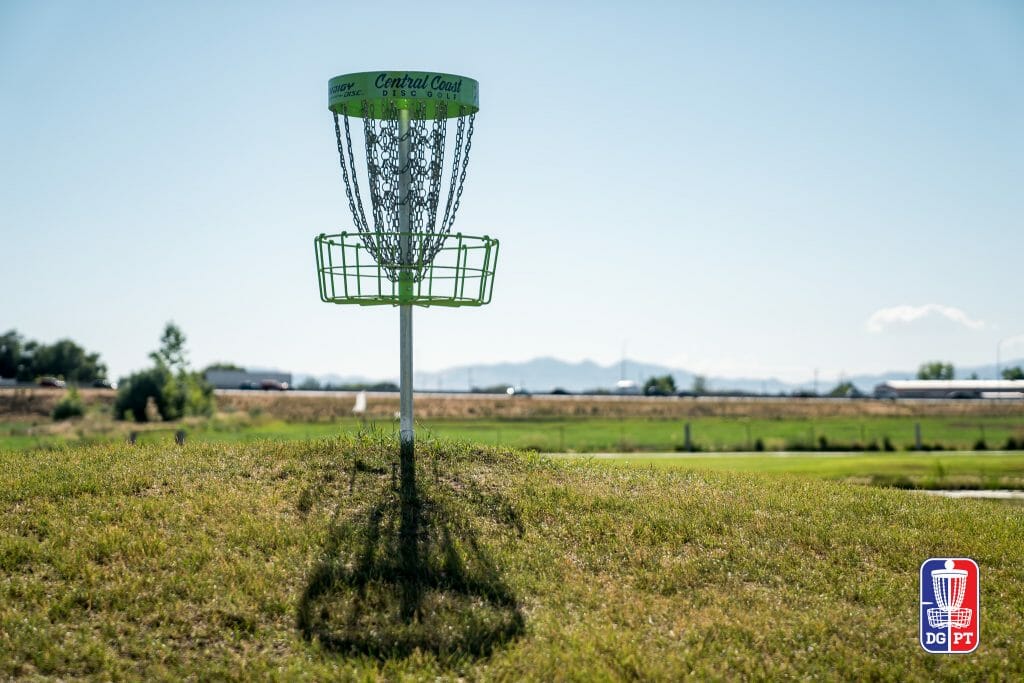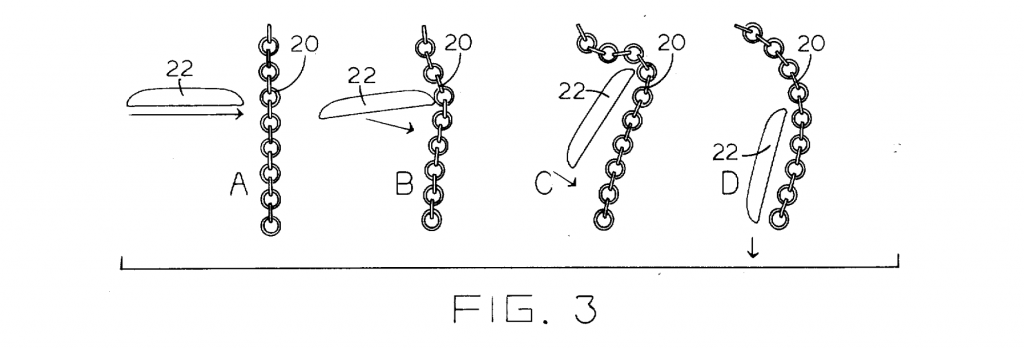Originally published at: https://discgolf.ultiworld.com/2018/09/04/circle-2uesday-honey-shrunk-baskets/
[caption id=“attachment_10837” align=“aligncenter” width=“1024”]
Maybe I’m a little late to the party. Or maybe I’m just trying keep the conversation front and center. Whatever the case, I want to talk about baskets and basket size.
A bit of history, first. “Steady” Ed Headrick invented the pole hole 43 years ago in 1975. It is an iconic device today, synonymous with disc golf. Based on the diagrams he submitted to the U.S. Patent Office, his “flying disc entrapment device” comprises a two-part catching apparatus: the chains and the basket. ((The pole itself might be considered part of the catching apparatus as well, but it is not mentioned in this capacity in Headrick’s patent application.)) Ultimately, the goal is to hole out by having the disc come to rest in the basket itself. Today, that basket is approximately three discs in diameter.
Before continuing any further, it should be noted that “Steady” Ed did not propose standardized dimensions in his patent application.
[caption id=“attachment_10825” align=“aligncenter” width=“1024”]
Sketch from original “flying disc entrapment device” patent application.[/caption]Ever since the DGPT roundtable, “Should Baskets Be Smaller,” set the disc golf community ablaze with hot takes, I’ve been weighing my response. Truthfully, I’ve been stunned by the number of respondents against the idea and the general polarity of opinions overall. There’s not much middle ground out there in the fiery aether. So where do I stand?
Conditionally: I think that baskets should be smaller.
Do I advocate using sharpshooters, marksmen, skinny minnies…whatever we want to call the single chain practice totems? Definitely not.
Do I support a wholesale change to some TBD future basket in 2019? Or 2020? Nope.
What I want is for basket manufacturers to submit the concept of a smaller, tournament-worthy target to R&D. Let’s see some prototypes. Get the pros to put ‘em through their paces. Get the ams to try ‘em out at demos. Debating the catching capabilities of a smaller basket is entirely a theoretical exercise until a target exists to critique.
Okay, but why do I think disc golf should adopt a smaller target? Most simply, I want to increase the challenge of the game – for me, not just the professionals – and because I see the size of our basket as being anomalous compared to similar scoring targets in other sports. Better course design (no easy shots!) and better greens (away with the wide open 10 meter circles!) are part of the same discussion, obviously, but in my opinion, there’s no reason we can’t appraise various facets of the game simultaneously.
Let’s compare the specs of two similar targets to our own. Basketball and golf are the most common reference points, so let’s continue in this vein:
- The standard NBA size basketball is inflated to a circumference of 29.5 inches (9.39 inches in diameter). The rim is 18” in diameter, making target 1.92 times the size of the ball.
- The standard PGA Tour golf ball cannot have a diameter smaller than 1.68 inches. The cup is 4.25 inches in diameter, making the target 2.53 times the size of the ball.
- The PDGA stipulates that discs cannot be smaller than 21 cm (8.27 inches in diameter). The diameter of the chains at their widest point is approximately 22.5 inches and the tray is around 26 inches, making them 2.72 and 3.14 times the size of the disc.
If I were to make a suggestion to basket manufacturers, I would encourage them to reduce our target proportionally to bring it in line with the object-to-target ratio in golf as a first step. ((Adopting this ratio would change the proportions of the pole hole as follows (diameter of chains x diameter of basket x vertical span between basket & rim): from 22.5” x 26” x 18” to 18.13” x 20.95” x 14.5”. In other words, the chains and basket would narrow by ~2.25” and ~2.5”, respectively, on each side of the pole, and the vertical span would decrease by ~4”. Overall, the total reduction would be less revolutionary than many of us imagine.))
Looking at these numbers makes it hard for me to buy the argument that a smaller target would turn off recreational players. There are, after all, no shortage of recreational basketball players and golfers despite the fact that their targets present a greater challenge than ours.
Whether or not a smaller basket increases the regularity of lag putting – a significantly better term than “laying-up,” in my opinion – is hard to say without seeing the target in action. Ostensibly, the best putts on large or small targets are thrown flat and just clear the rim of the basket. A lower, centralized strike zone minimizes the possibility for chain-outs and cut-throughs. The higher into the chains you throw, the more variables you bring into play, the more likely you are to miss.
For instance, what I know for a fact is that this putt was going in regardless of the basket size.
2018 MVP Open | Final Round Paul McBeth hole 13
Look, disc golf is young. We’re still writing its early history now. It took 15 years for basketball to replace the peach basket with the metal rim and net combination we know today. In American football, the forward pass wasn’t legal until 1906, 30 years after the “invention” of the game. It would be a shame not to explore any and all avenues pertaining to competition, including adjustments to our equipment, as we develop this sport we love for future generations.


